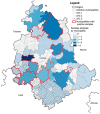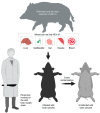Detection of Hepatitis E Virus in Game Meat (Wild Boar) Supply Chain in Umbria Region, Central Italy
- PMID: 39200431
- PMCID: PMC11353911
- DOI: 10.3390/foods13162504
Detection of Hepatitis E Virus in Game Meat (Wild Boar) Supply Chain in Umbria Region, Central Italy
Abstract
Consumption of raw or undercooked wild boar (WB) meat is considered an important risk factor for hepatitis E virus (HEV) infection in humans. The possibility of HEV contamination during the slaughtering practices may pose an additional risk. Based on these assumptions, we evaluated HEV contamination of WB meat hunted in Umbria (central Italy) during the 2022-2023 hunting season by real-time RT-PCR. Herein, we show that 10.8% of livers from slaughtered WB were positive for HEV RNA, thus providing an estimate of HEV infection in WB in the Umbria region. Then, by evaluating paired liver-muscle samples from both HEV-positive and HEV-negative animals, we found evidence of muscle HEV contamination in 33% and 14% of cases, respectively. This is the first report on the detection of HEV in WB meat in Umbria, an Italian region with diffuse WB hunting and consumption. The evidence of contamination provided by our study underscores the importance of adopting good hygienic practices in the processing stages of hunted WB carcasses to significantly reduce meat contamination and the risk posed for the final consumer.
Keywords: HEV; food safety; foodborne transmission; hunted wild boar (WB) meat.
Conflict of interest statement
The authors declare no conflict of interest.
Figures





Similar articles
-
Hepatitis E Virus RNA Presence in Wild Boar Carcasses at Slaughterhouses in Italy.Animals (Basel). 2021 May 31;11(6):1624. doi: 10.3390/ani11061624. Animals (Basel). 2021. PMID: 34072795 Free PMC article.
-
Molecular survey of HEV infection in wild boar population in Italy.Transbound Emerg Dis. 2018 Dec;65(6):1749-1756. doi: 10.1111/tbed.12948. Epub 2018 Sep 11. Transbound Emerg Dis. 2018. PMID: 30207081
-
Longitudinal serological and virological survey of hepatitis E virus in wild boar (Sus scrofa majori, Maremman wild boar) and fallow deer (Dama dama) populations in a protected area of Central Italy.Front Vet Sci. 2024 Nov 27;11:1511823. doi: 10.3389/fvets.2024.1511823. eCollection 2024. Front Vet Sci. 2024. PMID: 39664896 Free PMC article.
-
Hepatitis E virus (HEV) genotype 3 diversity: Identification of a novel HEV subtype in wild boar in Central Italy.Transbound Emerg Dis. 2021 Jul;68(4):2121-2129. doi: 10.1111/tbed.13860. Epub 2020 Oct 20. Transbound Emerg Dis. 2021. PMID: 33006818
-
Foodborne transmission of hepatitis A and hepatitis E viruses: A literature review.Int J Food Microbiol. 2021 Jan 2;338:108986. doi: 10.1016/j.ijfoodmicro.2020.108986. Epub 2020 Nov 19. Int J Food Microbiol. 2021. PMID: 33257099 Review.
Cited by
-
Foodborne Pathogens Across Different Food Matrices in Sicily (Southern Italy).Pathogens. 2024 Nov 14;13(11):998. doi: 10.3390/pathogens13110998. Pathogens. 2024. PMID: 39599551 Free PMC article.
-
Case of Fatal Hepatitis Related to HEV-3 Infection in Central Italy.Viruses. 2024 Nov 30;16(12):1869. doi: 10.3390/v16121869. Viruses. 2024. PMID: 39772179 Free PMC article.
References
LinkOut - more resources
Full Text Sources

